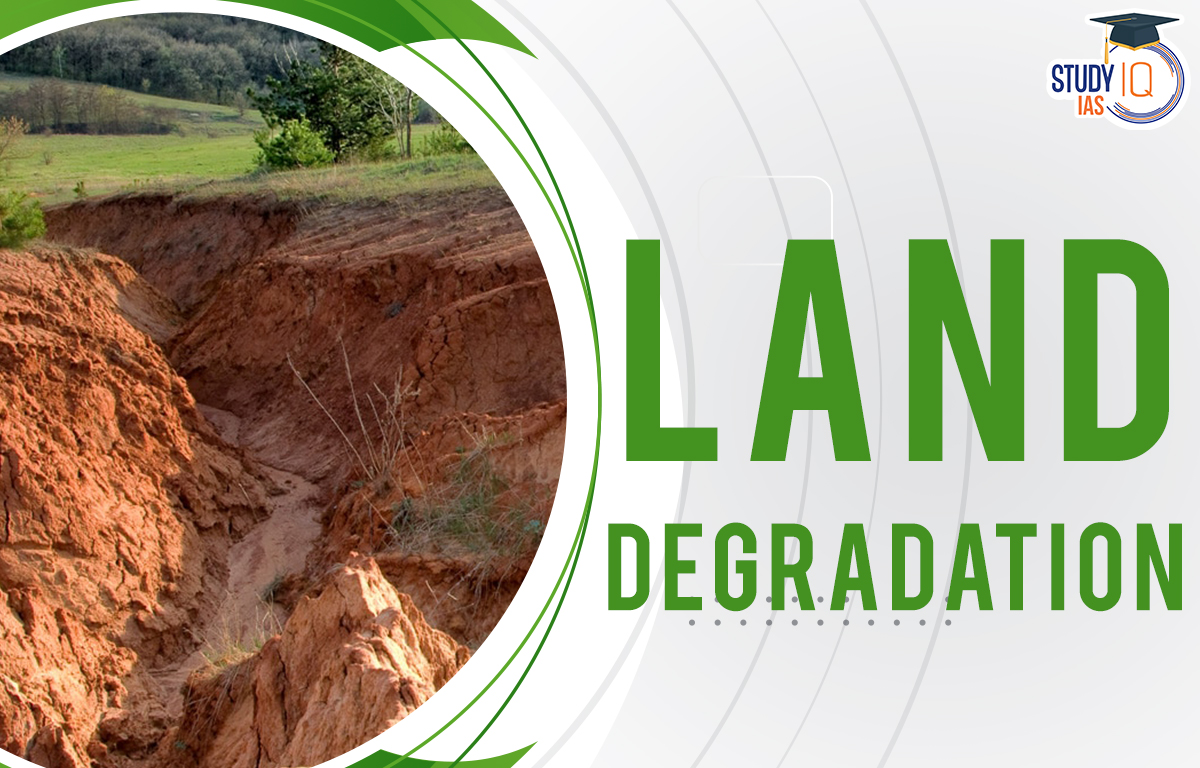Table of Contents
Land degradation means the soil is getting worse because it is being used in the wrong way, like for farming, grazing animals, building factories, or cities. This is a big problem around the world and can get worse with climate change. It includes things like soil erosion, salty or polluted soil, and the loss of plants that grow on the land.
Land degradation happens because of many reasons, like extreme weather, especially drought. Just like air and water, land is very important for people. When land gets worse, it can cause problems like not having enough food, higher food prices, climate change, environmental risks, loss of different plants and animals, and fewer natural services from the land. This means the soil can not produce as well now and in the future.
Land Degradation Meaning
Land Degradation happens when the quality of the land gets degraded because of natural or human reasons. This can lead to less productive soil, fewer plants and animals, and fewer natural benefits from the land, which can greatly affect the environment and human societies. Common causes include cutting down trees, overgrazing by animals, soil erosion, pollution, building cities, and climate change.
Land degradation can make the soil less fertile, reduce its ability to grow crops, and support livestock, which can hurt local economies and food security. Environmental impacts include soil erosion, loss of biodiversity, and poorer water quality. These problems, like flooding, drought, and desertification, can make climate change worse and also be worsened by it.
Land Degradation Causes
- Unsustainable Agriculture:
- Monoculture farming practices.
- Overuse of chemical fertilizers and pesticides.
- Improper irrigation techniques.
- Poor soil management.
- Deforestation:
- Clearing forests for agriculture, logging, and urbanization.
- Disrupts ecosystems and increases soil erosion.
- Alters water cycles and reduces biodiversity.
- Overgrazing:
- Excessive grazing by livestock.
- Leads to vegetation degradation.
- Causes soil compaction, erosion, and loss of fertility.
- Urbanization:
- Expansion of cities and infrastructure.
- Converts productive land into impervious surfaces.
- Results in soil sealing and disrupts water cycles.
- Mining:
- Extraction of minerals and resources.
- Causes habitat destruction and deforestation.
- Contaminates soil and water with toxic chemicals.
- Land Pollution:
- Industrial waste disposal.
- Pesticides, heavy metals, and other pollutants contaminate soil.
- Renders land unsuitable for agriculture and poses health risks.
- Climate Change:
- Alters temperature and precipitation patterns.
- Increases frequency of extreme weather events.
- Exacerbates processes such as desertification and soil erosion.
- Soil Mismanagement:
- Improper land-use planning.
- Inadequate soil conservation practices.
- Lack of land-use regulations.
- Intensifies erosion and habitat destruction.
Types of Land Degradation
Land degradation refers to the deterioration of land quality and productivity. There are various types of land degradation, each caused by different factors and processes. Here are some of the main types:
| Type of Land Degradation | Description |
|---|---|
| Soil Erosion | Topsoil removal by wind or water, often due to unsustainable farming practices, deforestation, or natural disasters. |
| Desertification | Transformation of fertile land into desert, typically caused by climate change, overgrazing, deforestation, and unsustainable agriculture. |
| Salinization | Accumulation of salts in the soil due to irrigation with saline water, making it unsuitable for plant growth. |
| Soil Compaction | Compression of soil particles, reducing pore space and limiting air, water, and nutrient movement, often caused by heavy machinery, grazing, or urbanization. |
| Loss of Soil Fertility | Decline in soil fertility due to overuse of chemical fertilizers, monoculture farming, and poor soil management practices. |
| Deforestation | Removal of forests for agriculture, logging, or urbanization, leading to soil erosion, disrupted water cycles, and biodiversity loss. |
| Urbanization | Expansion of cities and infrastructure, resulting in the loss of productive land, disruption of ecosystems, and increased pollution. |
| Mining | Extraction industries causing land degradation through vegetation removal, soil erosion, contamination, and alteration of landscapes. |
| Land Pollution | Contamination of land by industrial chemicals, pesticides, heavy metals, or hazardous waste, rendering it unsuitable for productive use. |
| Overgrazing | Excessive grazing leading to vegetation degradation, soil erosion, and loss of biodiversity on pastureland. |
Land Degradation Effects
Land deterioration threatens agricultural productivity and worsens soil health, affecting the quality of life for rural residents. It also makes climate change events worse, causing more damage. For example, degraded land can not absorb carbon dioxide (CO2), a major greenhouse gas that contributes to global warming.
Land degradation has also reduced the quantity and quality of surface and groundwater. With 1.5°C warming, 178 million people in dry areas could face water stress and intense drought by 2050. Insecure land ownership makes it harder for people and communities to fight climate change, increasing the risk of land degradation.
Land Degradation Neutrality
Land Degradation Neutrality (LDN) is a goal to stop and reverse land degradation. It means keeping the amount and quality of land stable or better over time. LDN is part of the 2030 Agenda for Sustainable Development and aims to combat desertification and restore land by 2030.
LDN objectives include:
- Maintaining or improving ecosystem services
- Enhancing land productivity for global food security
- Increasing the resilience of land and its dependent populations
The UNCCD and Sustainable Development Goals (SDGs) for 2030 include LDN. The GEF has helped over 60 countries integrate LDN into their plans.
Land Degradation in India
From 2015 to 2019, 30.51 million hectares of land were degraded, which is 9.45% of India’s land. An estimate shows that 96.40 million hectares, or 29.32% of India’s total land, were degraded between 2011 and 2013. In comparison, 94.53 million hectares were degraded between 2003 and 2005. Agricultural land and forests are the most affected. Climate change and human activities make this worse, reducing the land’s productivity, health, and biodiversity.
- According to the UNCCD, 32% of India’s land is degraded, and 25% is turning into desert.
- Natural causes include earthquakes, volcanic eruptions, and heavy rain. Human causes include deforestation, overgrazing, and poor land management.
- Land degradation harms farmers and forest dwellers, reducing land productivity, health, and biodiversity.
- India has schemes like the Green India Mission and the Mahatma Gandhi National Rural Employment Guarantee Scheme.
- India also joined the Bonn Challenge, aiming to restore 13 million hectares by 2020 and 8 million more by 2030.
- Rajasthan, Uttar Pradesh, and Telangana have reduced degraded land in the last 15 years. Delhi still has a high percentage of degraded land, with nearly 62% affected.
To tackle this, the Space Applications Centre in Ahmedabad has created an online portal to show degraded areas and their causes.
Some strategies to reduce land degradation include:
- Rooftop rainwater harvesting: In places like Junagarh, Gujarat, small houses collect rainwater for household use.
- Zero Budget Natural Farming (ZBNF): This helps farmers use sustainable farming methods to improve soil fertility and cut costs.
- Soil Health Cards (SHC): Farmers get information about their soil’s condition to help restore its health.
Land Degradation Prevention
To fight land degradation, we can use methods like planting trees, controlling erosion, and practicing sustainable farming. We can also reduce the causes of land degradation by limiting deforestation and improving waste management.
Land Degradation UPSC
The term “land degradation” describes the deterioration of the condition of the land, which can be brought on by human activity or by natural processes such soil erosion or climate change. The causes and effects of land degradation may be covered in the UPSC exam. Studying land degradation for the UPSC exam is crucial because it has a big impact on environmental preservation and sustainable development. Students can read all the details related to UPSC visiting the official website of StudyIQ UPSC Online Coaching.


 Purchasing Power Parity Index, How to Ca...
Purchasing Power Parity Index, How to Ca...
 Unemployment Rate in India, Current Rate...
Unemployment Rate in India, Current Rate...
 RBI Monetary Policy Committee: Repo Rate...
RBI Monetary Policy Committee: Repo Rate...

























